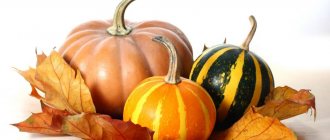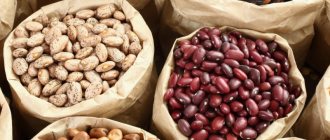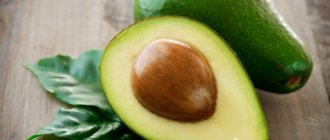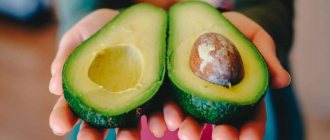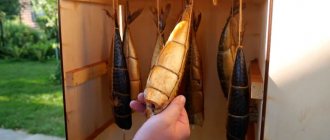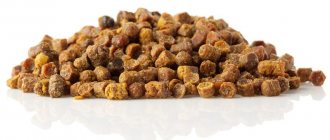Pumpkin is a real storehouse of vitamins and microelements that are necessary for the human body. This vegetable can grow in a wide variety of climate zones. If you care for it correctly, you can count on a good harvest. But it’s not enough to just grow it. It is important to know how to store pumpkin in order to leave all its valuable properties unchanged.
General features of pumpkin
Pumpkin has a round or oval shape. In total, there are 30 varieties of vegetables, which differ in fruit weight, density, taste and ripening time. There may also be differences in the color of the peel, which can be orange, beige, greenish and yellow. What types are distinguished:
- canteens intended for human consumption;
- feed - they are intended for feeding large and small livestock;
- decorative - they are used to decorate original dishes, and they are also a good material for crafts.
Depending on the individual species considered, the weight of the fruit can vary from 2 to 200 kg. This vegetable first appeared in human nutrition 2,500 years ago. South America is considered the birthplace of pumpkins. But today it has successfully spread throughout all CIS countries. She managed to gain large-scale popularity only 400 years ago.
Nowadays the healthy vegetable is used in the preparation of various dishes. In this case, you can use not only the pulp, but also the seeds. Needlewomen make dishes from the peel, as well as various types of crafts. The pulp is suitable for desserts and sauces. You can also make porridge and soups from it. The seeds serve as the basis for the production of natural oil. The beneficial properties of such products are as follows:
- strengthen the immune system due to the content of vitamin C;
- normalize the activity of the central nervous system;
- eliminate heart dysfunction;
- normalize falling asleep and improve sleep;
- have a positive effect on the condition of the epidermis, nails and hair;
- preserve youth and help get rid of excess weight;
- promote normal blood clotting and provide balance in metabolism.
Pumpkin contains a significant amount of iron. However, in order for all these valuable properties to be fully used, storage requirements should be taken into account.
Long term storage
This option is not suitable for all varieties. It is believed that nutmeg pumpkins are the most delicious. However, they can be kept in the pantry for no more than 2 months. If you want to enjoy your favorite vegetable in winter, you should give preference to large-fruited samples. They are quite soft and airy in taste. For winter storage the following varieties should be planted:
- Zhdana;
- Kherson;
- Dacha;
- Juno;
- Hylea.
These varieties also tolerate transportation well. The pulp of most of the presented varieties is sweet and dense.
Varieties suitable for long-term storage
To make preparations for the winter, first of all you need to know which variety is more suitable for storage. There are a large number of pumpkin varieties, but late-ripening ones are suitable for long-term storage. They have a thick and elastic peel, which preserves the integrity of the product for a long time without loss of beneficial vitamins and microelements.
In addition, pumpkin is divided into large-fruited and small-fruited varieties. Large-fruited ones have a longer shelf life - up to 8 months.
Small-fruited ones are less stable - they are stored for 3-4 months. However, with a shorter shelf life, small-fruited varieties have a richer and more pleasant taste.
The following varieties of pumpkin are best stored:
- Khersonskaya is a large-fruited variety. The weight of the fruit varies between 3–6 kg. Has a delicate sweet taste.
- Zhdana is a large-fruited variety. The weight of one fruit reaches 6–8 kg. The flesh is rich orange in color and has a sweet taste.
- Slavuta is also a large-fruited pumpkin that ripens towards the end of the summer season. The fruit is small in size - only 3–3.5 kg. The pulp is rich orange in color, loose in structure, and has a sweet, delicate taste.
- Mozoleevskaya-15 is a hard-barked variety that belongs to the mid-season species. The weight of one fruit reaches 8 kg. The pulp is bright yellow, firm, and has a rich sweet taste.
- Arbatskaya is a late-ripening nutmeg pumpkin. The fruits are large, reaching 5–9 kg. The pulp is reddish-orange, crispy, juicy.
- Gilea - refers to the muscat pumpkin varieties. The fruits are large, weighing at least 9 kg. The pulp is bright in color, firm, crispy, juicy, sweet.
- Polyanin is another muscat variety that has an oblong shape. The weight of the fetus reaches 4 kg. The pulp is firm and juicy in taste.
- Ioannina is a mid-season nutmeg variety. The average weight of one fruit is 6.5 kg. The pulp is juicy and sweet.
Choosing the right fruits
You should choose fruits for home storage for the winter from late-ripening varieties, as they last longer. The fruit should be deep orange in color and have a firm surface without scratches or dents.
Vegetable collection
Fruit ripening is observed in September or in the second ten days of October. The gardener needs to correctly determine whether the crop is ready for harvest. What rules are provided here:
- Collection should only be carried out in clear weather. If the sun does not appear for a long time, there is no need to postpone the process.
- The temperature at night should not fall below zero. If this happens, the fruit may freeze. When frosts form, you should cover the bed with a layer of plastic film overnight.
- If you start collecting in rainy weather, in the future the vegetables will need to be placed in a separate place to dry. The moisture will evaporate in about 2 weeks. In this case, a small distance should be maintained between the fruits.
A sign of maturation can be considered a dull sound when tapping on the bark. The peel itself becomes hard. The stalk also deserves attention. It should be dry. Harvesting that is not ripe is not recommended. In this case, the shelf life will be much shorter. Compliance with all necessary conditions protects the fruit from rot and preserves minerals and vitamins in the pulp.
Before storing, remove the stem using a well-sharpened knife. In this case, it is important to leave a fragment of the tail 5 cm long. The cut must be smooth, otherwise the damaged area will turn into an “entry gate” for bacteria. This will start the rotting process. Large fruits should not be grabbed by the stalk to move from place to place. It may break off.
To select vegetables, specimens that are deformed or injured are set aside. If all the fruits are damaged, the areas with defects should be treated with a solution of brilliant green. At home, they must be kept dry , otherwise they will be attacked by rot. If you pay attention to the appearance and keep the collected specimens dry, they can be preserved until the New Year.
How to store pumpkin in the freezer
For long-term storage, for example, if you want to stock up for the winter, a refrigerator compartment is indispensable. In it, the product will retain all its beneficial properties and flavors. The size of the pieces into which the product is cut for storage is determined based on what kind of dishes you will be preparing.
It is not recommended to cut the pumpkin after defrosting. In the freezer, the pulp can last for six months, and sometimes longer, without problems or loss of quality. If the temperature is very low (from -18°C), then it can be stored for a year.
Raw
This storage method is simple: peel, remove the core and seeds, cut into cubes and place in bags. It is not advisable to place a whole pumpkin in one container, since it cannot be re-frozen and you will have to cook everything that has been thawed.
There is a caveat - when frozen, the product expands, so you should leave some space in the container, container or bag so that the container does not burst. Or, initially freeze the pieces on a cutting board, and only then place them in a bag. If you arrange them so that the pieces do not touch, then they will not stick together in the bag when frozen.
Blanched
Store the vegetable in pieces in containers, but pre-process it as follows:
- Place pieces of pulp in a colander;
- Place in boiling water for three minutes;
- after - cold, also for three minutes;
- Cool and dry on an absorbent surface (such as napkins or a towel).
I'll grind it
Grated pumpkin takes up less space. This storage is suitable for freezing preparations, for example, fillings for future baking. To do this, grate the chopped pieces on a coarse grater.
The storage method is no different from the usual freezing of raw pulp. As containers, you can use special ice molds, plastic cups covered with foil, and special food containers.
If you have nothing but a bag, then to give it shape you can first put it in a container, place the product and freeze it before placing it in the freezer.
Video: how to freeze pumpkin
baked
To bake, a whole pumpkin should be peeled inside (do not remove the skin), cut into large slices and placed on a baking sheet, skin side down. Bake for an hour at t° 200 C.
You can store it either in pieces, cutting off the skin, or as a puree. For the second option, after baking, the pulp is ground in a blender to a homogeneous consistency and packaged in the same way as the ground one.
Temperature Requirements
It is necessary to determine the storage temperature in winter so that the vegetable can be preserved for as long as possible. The optimal ranges are from +5 to +15 degrees. This mode helps preserve the juiciness of the pulp. If it is possible to maintain a level not lower than the specified indicators, the pumpkin will be suitable for consumption until spring.
Pumpkin can be stored at home in the freezer. In addition to temperature, the availability of fresh air and humidity are important. The latter should be at a level of no more than 70%. This eliminates the possibility of mold formation. But it should also not fall below 60% so that the structure of the vegetable does not become too dry.
Optimal conditions for storing pumpkin
How to store pumpkin in an apartment? To successfully store the pumpkin harvest, three mandatory conditions must be strictly observed:
- maintaining a stable temperature;
- excluding the possibility of direct sunlight;
- avoiding contact of fruits with each other.
The critical lower limit can be considered a temperature of plus two degrees and below; the upper permissible temperature limit should not be higher than twenty to twenty-two degrees.
The temperature range favorable for storing pumpkin is quite wide. Exceeding both values leads to rapid spoilage of the fruit.
Not only temperature fluctuations, but also changes in air humidity have an extremely negative impact on the safety of fruits.
Overall
What are the optimal conditions for storing pumpkin in winter at home? In a city apartment, there is a choice of two most successful ways to store fruits in their entirety.
The first option involves storing pumpkins at home in winter on a glazed balcony or loggia, subject to the following conditions:
- the room temperature does not drop below plus two degrees;
- pumpkins should be covered with an opaque, breathable material that prevents the penetration of sunlight;
- if pumpkins are stored without additional containers (boxes, baskets, boxes, etc.), it is necessary to ensure their insulation from the cement floor, linoleum, plastic;
- It is advisable to place plywood, boards, thick fabric, or, in extreme cases, newspapers under the pumpkins;
- When severe frost sets in, pumpkins should be insulated by covering the top with additional warm material (blanket, insulation, etc.).
Not everyone has a prepared loggia or balcony, but an equally reliable way to preserve pumpkins for a long time is to store them directly in the apartment in places with the lowest air temperature, that is, on the floor, ensuring that the fruits are isolated from each other and away from sunlight.
Both options for storing pumpkins for the winter at home have their advantages and disadvantages, as well as risks associated with damage to the crop.
When storing on a loggia or balcony, it is important to ensure that rot and mold do not occur and spread due to high air humidity.
In room conditions, on the contrary, it is necessary to prevent the fruits from drying out, ventilate more often, and if the air is very dry, it is advisable to use humidifiers.
Cut fruits
Pumpkins are often so large that it is impossible to eat them all at once.
In this case, it is important to follow some rules that will allow you to store pumpkin in the refrigerator without losing the quality of the product and its benefits.
How to store a cut pumpkin? The rules are simple:
- Wash the pumpkin and cut it as needed for cooking.
- Remove the seeds with peri-seed pulp from the entire (!) pumpkin.
- The part of the product that you do not plan to use immediately does not need to be peeled, this way the pumpkin will better retain its juiciness.
- Wrap the unpeeled part of the pumpkin in cling film or foil, or put it in an airtight container and put it in the refrigerator on any shelf.
In this form, cut pumpkin can be stored for up to ten days.
Sometimes you need to cut a pumpkin for several dishes at once, but they will be prepared one by one (for example, for juice, salad, puree soup, for stewing or baking). How to store cut pumpkin at home?
In this case, the entire pumpkin should be washed, peeled, seeded, cut into pieces, sealed and placed in the refrigerator on the top shelf. How long can you store already peeled pumpkin?
This way it will retain its original qualities for two to three days and can be successfully used for any dish except juice.
This is interesting: Tractor "Belarus" MTZ-1523 - description, manufacturer, technical characteristics, direction, photo
Accommodation in an apartment
Once the harvest is harvested, the question arises of choosing a place for further storage. When it comes to a private house with a basement, there is no problem as such. If it is not there, you will have to organize a special place to place rather large fruits. According to reviews from lovers of this vegetable, it is perfectly preserved on the balcony or loggia.
It should be laid out on shelves covered with fabric or cardboard. The balcony should be glazed, but it is also important that fresh air flows in here. Fungal infections, dampness, and the prospect of freezing are unacceptable. Pumpkin likes shade , so it is better to cover the shelves with thick fabric or hang curtains.
Despite the need to maintain some distance, it happens that there are a lot of fruits, but the area is limited. In this case, you can separate them from each other with paper.
Stowing in the refrigerator
If incomplete processing has been carried out, the pumpkin can be placed in the refrigerator. The same goes for winter stocks that have been damaged after pruning. It is not advisable to send whole fruits here. Areas that are not covered by the peel should be wrapped with foil or film. This way you can keep the pumpkin for up to 2 weeks. This period can be increased to a month if we are talking about a modern refrigerator model equipped with an antibacterial system.
To prevent moisture from evaporating from the cut surface, you should lubricate the surface layer with a small amount of sunflower oil. You should take one that has no smell. The layer should be thin, so it is better to use a pastry brush for this manipulation.
In the form of jam
To prepare delicious pumpkin jam, you need to take the following products:
- 1 kg pumpkin;
- 1 kg sugar;
- 300 ml water.
To prepare this dish you need to follow these steps:
- Mix sugar with water and cook syrup. As a result, the consistency should be quite thick so that thin threads appear.
- The peeled pumpkin should be cut into 1 cm cubes.
- Pour syrup over the vegetable and cook until fully cooked. This must be done within a quarter of an hour.
- Pour the jam into jars, close and put in the basement or refrigerator. This jam can be stored for 1.5 years.
The freezer is the best place
You can store cut pumpkin at home in the refrigerator or freezer. The second is rightfully considered the best place to store pumpkins. To prepare a dish using it, you just need to take out the pieces. To freeze a vegetable, you need to cut it into small pieces and then place them in containers or freezer bags. Some people advise saving it entirely.
You can cut it in half, then use one half, wrap the other half in cling film and put it in the freezer. Here it can be stored for quite a long time. You can mix the slices with other vegetables and fruits if you plan to use them to prepare a stew.
Puree
You can make a preparation for soup or sauce from pumpkin. It can be baked with herbs and salt, and then pureed.
The crust needs to be peeled off the baked pumpkin; this will be much easier to do than with a raw one.
This puree can be refrigerated, placed in a tightly sealed jar, where it will keep for 10-12 days. Or you can put it in containers and freeze it. And already make soup from thawed puree. Yes, in this case the pumpkin will lose some nutrients, but this is better than rotting completely and ending up in the trash.
Pumpkin conveyor. A variety of varieties will always allow you to have a vegetable on the table. Read more
Drying slices
When thinking about where to store pumpkin at home, you should choose dry rooms with enough space. When there is no place to store fresh fruits, drying technology comes to the rescue. For this purpose, the pumpkin is cut into pieces no more than a centimeter thick. After this, they clean it of seeds and wash it with hot, slightly sweetened water. Next, the pieces are dried and placed in a preheated oven or electric dryer at a temperature of 50-60 degrees.
The pumpkin will have to stay in the oven for up to 6 hours. The time for drying the pumpkin in the dryer depends on the specific model. The temperature must remain constant. You should not exceed it, as in this case the pulp will be baked and not dry.
Modern models of electric ovens provide low-temperature modes. This is an excellent option for drying vegetables. You can put pieces of fruit in the chamber and not worry about their condition.
After the slices are dried, they are wrapped in a layer of thick paper or parchment. Next they are placed in a dry and dark place. If there is no suitable space to place them, you can resort to conservation technology. Pumpkin makes excellent candied fruits, purees and juices. The seeds can be collected, washed under running water and dried. This is an independent delicacy; they are also suitable for decorating pies and salads. This product is very useful for women and men.
Caramel pumpkin and grilled chicken
Photo: Grand Cafe “Dr.
Zhivago" Recipe by Victor Grimailo, chef of the Grand Cafe "Dr. Zhivago"
- 120 g chicken fillet
- 80 g pumpkin
- 70 ml sugar syrup
- 30 g quinoa
- 80 g tomato
- 25 ml olive oil
- 10 ml lemon juice
- Salt and pepper
Step 1. Cut the pumpkin, pour hot syrup, it will be ready in half an hour.
Step 2. Marinate the chicken fillet (olive oil, lemon juice, salt, pepper) and grill until cooked. It is advisable to serve the salad when the fillet is still warm.
Step 3. Boil the quinoa and cool.
Step 4. Cut the tomatoes into large segments.
Step 5. Season all ingredients with olive oil, lemon juice and salt, place on a plate.
Step 6. Cut the fillet and place it last.
In the basement and cellar
If the basement does not freeze, even when it is frosty outside, it is well suited for storing crops. It's important to keep it dry. At the same time, it is necessary to have the possibility of ventilation. Pumpkin is well preserved in the cellar. This method works well even for beginners. True, shelving will have to be built here. The shelves themselves must be dry. They are covered with high-quality straw.
The fruits are placed upside down at a short distance from each other. From time to time they are turned, inspect the straw, and find out if there are pests or mold. If any traces of damage are detected, it is not recommended to store such a crop any further. It should be reworked. If the pumpkin remains intact, but some fragments had to be cut off from the peel, it is enough to treat them with a disinfectant compound or seal them with a bactericidal plaster. After this, you should take them into the house. The vegetable will remain edible for up to 7 days at room temperature.
What to remember
To store pumpkin for a long time, you must follow the following rules:
Choose a pumpkin for storage without damage and with a good strong tail. Photo: gazeta19.ru
- Store in a dry and cool place. The pumpkin is well preserved whole if it is stored in the pantry of an ordinary apartment, away from radiators. It should be wrapped in paper or cloth to prevent moisture from escaping.
- Store frozen. Freezing pumpkin is the most affordable way to preserve vegetables. The pieces should be placed in portioned bags so as not to defrost large portions. Repeated freezing is destructive.
- Dry with thin plastics. The slices will dry better and faster if they are cut into thin layers.
- Store in glass or ceramic containers. Dried vegetables are best preserved in glass or ceramic jars with well-pressed lids.
Cut pieces
Pumpkin is not always fully used. If the fruit has not been cleared of seeds and is planned to be stored in a large piece, the cut area must be covered with film and then the vegetable must be placed in the refrigerator. It will remain in this state for up to 3 weeks. If you plan to prepare something from it after the specified period, the top layer of pulp must be removed.
When the fruit is peeled and cut into pieces, completely different rules apply. Take a pastry brush and grease the slices with vegetable oil, wrap each individually in foil or film. If you select the first material and change it periodically, you can save the product for up to a month. It is not recommended to keep the vegetable in the refrigerator for longer than this period. It's better to freeze it.
Pumpkin soup with seafood
Photo: Press service of the restaurant "ERWIN.RiverMoreOcean"
Recipe by Alexey Ryabov, chef of the restaurant "Erwin.Reka"
- 150 g pumpkin
- 100 ml fish broth
- 50 g pike perch fillet
- 30 g squid
- 15 ml white wine
- 10 ml olive oil
- 10 g celery root
- Salt and pepper
- 2 mussels
- 2 shrimp
- Basil sprig
- 1 tooth garlic
- sprig of thyme
Step 1. Fry thyme, garlic, and all seafood in a saucepan for no more than 1 minute. Pour in white wine, evaporate, add half of the fish broth.
Step 2. Finely chop the red onion and celery root and fry in a frying pan.
Step 3. Bake the pumpkin with thyme and puree in a blender.
Step 4. Boil for a few minutes adding the rest of the fish stock. Adjust to taste with spices. Add some chopped basil.
Step 5. Transfer seafood to a plate, pour in broth and garnish with basil.
Common mistakes
The most common mistake is harvesting an unripe crop. Such fruits last much less time and begin to rot quickly. Gardeners often water crops when they shouldn’t. It is necessary to stop the flow of liquid 10 days before the intended cleaning.
After the vegetables are collected, they should be placed in a warm and dry place to dry. Some summer residents immediately put them in the cellar, which is why they are attacked by mold. The crop should always be placed on something soft and dry. If you choose concrete for this, rot will occur. Dry sawdust or straw are best suited for this.
It is important to sort by size. Large specimens should be placed next to equally large specimens. The best ones should not be stored at all, but sent immediately for conservation. In addition to the brilliant green solution, cracks and scratches should be treated with 100% potassium permanganate. It is not recommended to be near apples and pears during storage. These fruits emit ethylene, which helps reduce shelf life.
If you follow simple storage rules, this healthy and tasty product will be available for use throughout the winter. There are many interesting recipes with pumpkin pulp. The thick peel can be used for applications and crafts, and the seeds can be dried and consumed just like that.
How do you like the article?

